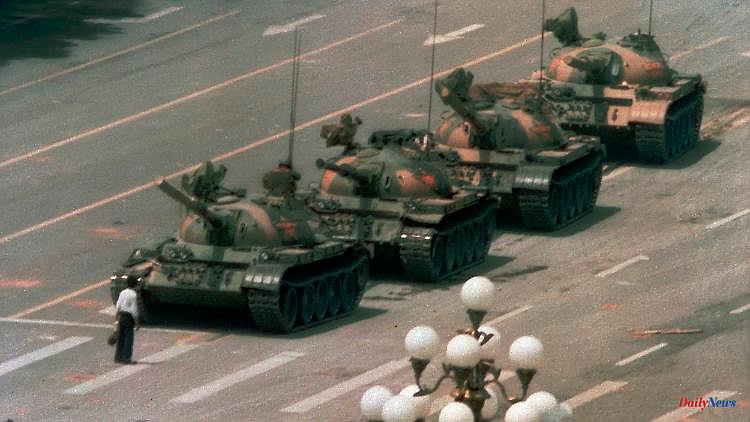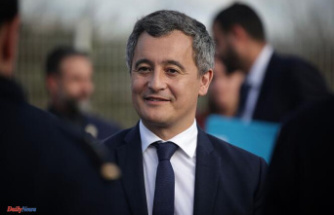On the morning after the massacre in Beijing, a Chinese man becomes the hero and icon of the struggle for freedom against the oppression of the masses. Because he stands in front of a rolling tank column, the international community dubs him "Tank Man". "Time" magazine elevates the unknown to the illustrious circle of the 100 most influential people of the 20th century. Because of him, too, societies in other parts of the world find the courage to rebel against dictatorial rulers.
It's only about three minutes on the morning of June 5, 1989 that turn a man into a hero. An unknown person blocks the way of a tank column of the Chinese army on Chang'an Jie in the heart of Beijing, in the immediate vicinity of Tiananmen Square. It remains unclear whether the man is an active member of the democracy movement, which had to pay with many lives for its demand for political participation the night before. Nevertheless, his courage went down in history as the last act of open resistance of those days and weeks in spring 33 years ago.
These few moments on the Chang'an Jie have literally burned themselves into the memory of the world public. No violence, no blood, and yet the images of this man confronting a state power armed to the teeth with two shopping bags in his hands evoke forever the many dead of Tiananmen. To this day, they exude a fascination that has created a global culture of remembrance that makes it impossible for the Chinese Communist Party to downgrade the massacre of its own people to a side note in history.
It is unclear who the man was and whether he was punished after several men pushed him off the street. But its importance goes far beyond the memory of the crimes committed by the Communist Party in 1989. "This young man changed the world," says Professor Bruce Herschensohn in the 2006 documentary "Tank Man." Herschensohn was once an adviser to Richard Nixon's US government and dealt extensively with communist regimes. "Tank Man's actions supported the transformation of the Soviet Union," believed the late Herschenson, who traveled to various Eastern European countries shortly after the events in Beijing.
In many places, people took to the streets at the time to protest against the pro-Soviet regime. Several times and in many different countries, according to Herschensohn, people would have said to him: "If this Chinese boy can stand in front of the tanks, then so can we."
The Berlin Wall fell five months after Tank Man. The collapse of the Soviet Union and the Eastern bloc followed. Many societies got rid of their despots and dictatorial governors under Moscow's leadership and developed democratic structures. But of all those upheaval and revolutionary days, no moment was remembered by the world like Tank Man's determination.
The US news magazine "Time" expressed his importance in the fight against the oppression of the masses by corrupt regimes by listing Tank Man as one of the 100 most influential people of the 20th century. erkor "The man with the tanks represents the power of the nameless," wrote the magazine in 1998.
To this day, the recordings are regularly dug out of the archives. Teaching staff in democratic countries use it as visual aids in history classes. Tank Man became popular culture. The unequal duel between man and tank adorns T-shirts and posters today and has even been taken up by a world-famous comic series. "It's the mystery that allows its enduring presence - that allows it to be a code for so many Western values and aspirations," said Jennifer Hubbert, of Lewis
In her article Appropriating Iconicity: Why Tank Man Still Matters in the Journal of the Society for Visual Anthropology, Hubbert describes what happens when the iconic Tank Man image is modified and repurposed for new political purposes. She concludes that the use of the image in new contexts in the US makes it less about the lack of political liberalism in China and more about democratic deficits in the United States.
In today's China, young people in particular have little detailed knowledge of Tank Man. His pictures and his story usually only make it through the party's censorship for a short time, if at all. Chinese textbooks treat the so-called "June 4th Incident" as exploits by the Chinese military. Official Chinese figures speak of several hundred dead demonstrators. There is a good chance that in reality there were probably thousands. Under the leadership of the KP, however, there will never be any information about the exact number of victims and there will never be a public investigation of the bloodshed.
With a high degree of sensitivity, she takes action against everything that reminds one of the night. Most recently, in 2016, four men were sentenced to several years in prison for sticking labels on liquor bottles that made reference to the deadly events. As a comic drawing, they had Tank Man and a bunch of tanks on it. It read, "Never forget, never give up".
Even 33 years after the massacre, it is not finally clear who the man was. As early as 1990, foreign media had identified him as Wang Weilin. Among other things, Herschensohn also claimed that he had learned this name from sources in Beijing. But this assumption was never confirmed. Nothing is known about the person behind the name Wang Weilin either. There are different versions of Tank Man's fate. One says he was executed at the end of June 1989, another says his execution was carried out months later. And later there were even rumors that Tank Man lived anonymously in Taiwan.
The theory of those who believe he went into hiding and survived relies primarily on the fact that Tank Man was not publicly executed. Following the events, a number of protesters were presented by name on television as a warning to the rest of the population and then killed. Their offenses were far less provocative than the tank blockade. Still, Tank Man wasn't executed like many others on state TV.
The question remains to this day who were the men who pushed him off the street. State security or ordinary citizens? A year after the massacre, US journalist Barbara Walters confronted future head of state Jiang Zemin with a photo of the tank man in an interview for the ABC channel. Jiang said he didn't think the man was killed. But he could not give any specific information. All the unanswered questions added to the myth in the years that followed.












